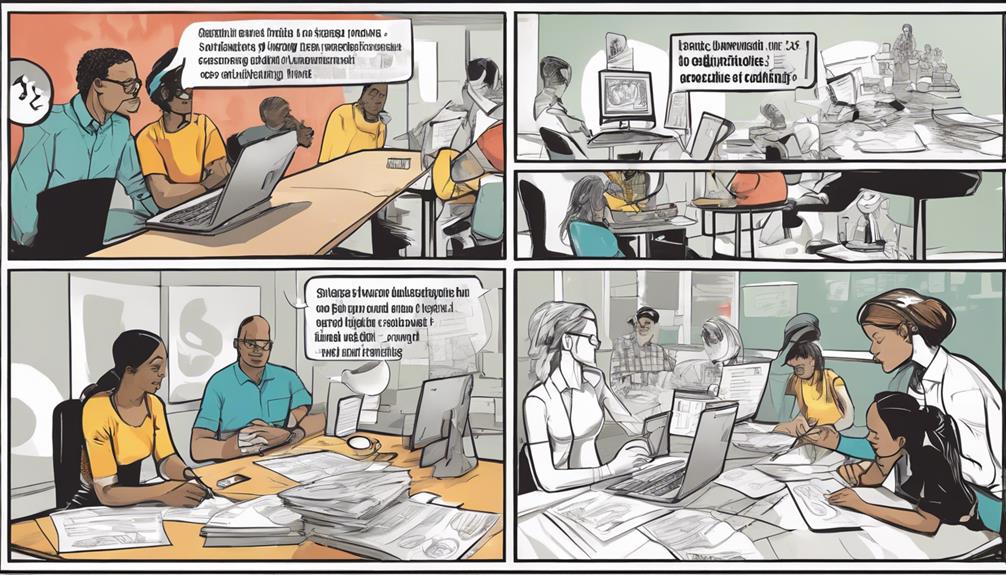To master problem framing, start by shifting your perspective to see challenges differently, uncovering new solutions. Ask open-ended questions that dig beneath surface symptoms to identify root causes. Challenge your assumptions to broaden your view and explore innovative ideas. Reframing problems as opportunities encourages creative thinking and resilience, leading to smarter decisions. If you keep exploring, you’ll discover even more powerful techniques to tackle bigger challenges effectively.
Key Takeaways
- Shift perspectives to reframe problems, uncover hidden opportunities, and develop innovative, impactful solutions.
- Ask open-ended, probing questions like “What if?” and “Why?” to explore root causes and broaden understanding.
- Challenge assumptions and bias to prevent narrow thinking and identify overlooked possibilities.
- Use techniques like 5 Whys and fishbone diagrams to analyze underlying issues comprehensively.
- Combine creative brainstorming with intuitive reasoning to develop proactive, bigger-picture strategies.
Understanding the Power of Perspective Shift

Have you ever noticed how changing your perspective can reveal new solutions? That’s the power of perspective shift. When you intentionally adopt different viewpoints, you *uncover* the benefits of mindset shifts, which can dramatically alter how you approach challenges. These perspective benefits often include discovering overlooked options, reducing emotional reactions, and gaining clarity. Instead of getting stuck on one way of thinking, shifting your outlook helps you see the bigger picture and identify smarter strategies. This mental flexibility allows you to reframe problems, making them easier to tackle. Embracing perspective shifts isn’t just about being open-minded; it’s about actively seeking new angles that can lead to innovative solutions and better decision-making. Additionally, cultivating curiosity can motivate you to explore alternative viewpoints and deepen your understanding, ultimately enhancing your problem-solving skills.
Identifying the Root Cause vs. Surface Symptoms

When solving problems, you need to tell the difference between surface symptoms and the root cause. Using effective diagnostic techniques helps you identify underlying issues rather than just addressing immediate signs. This clarity makes certain your solutions target the real problem, saving time and resources. Incorporating fraud detection tools such as machine learning algorithms and real-time monitoring can significantly improve your ability to uncover the true source of issues.
Distinguishing Symptoms and Causes
How can you tell the difference between a surface symptom and the true root cause of a problem? It starts with symptom analysis—examining the visible signs to gather clues. Surface symptoms often appear quickly and seem urgent, but they don’t reveal what’s truly behind the issue. To identify the cause, ask probing questions: Why is this happening? What underlying factors contribute? Effective cause identification requires looking beyond immediate effects and digging deeper into processes, patterns, or systems. Keep in mind that addressing only symptoms may provide temporary relief, while uncovering the root cause leads to lasting solutions. Understanding problem framing helps you distinguish between superficial issues and core challenges. By distinguishing between symptoms and causes early on, you set yourself up for more accurate problem framing and smarter, more sustainable resolutions.
Effective Diagnostic Techniques
What are the most effective diagnostic techniques for distinguishing between surface symptoms and the true root cause? Start by using diagnostic tools like data analysis, process mapping, and root cause analysis frameworks. Inquiry techniques such as the “5 Whys” or fishbone diagrams help you dig deeper beyond initial observations. Ask targeted questions to uncover underlying issues rather than settling for immediate symptoms. Focus on gathering evidence through observations, interviews, and data to identify patterns and inconsistencies. Challenge assumptions and test hypotheses to verify whether what you’re seeing is a surface symptom or a sign of a deeper problem. Incorporating natural materials and authentic decor can also reveal insights about underlying patterns or issues in a space. These diagnostic tools and inquiry techniques enable you to peel back layers and pinpoint the core issue, leading to more effective and lasting solutions.
Crafting Open-Ended Questions for Clarity

When you craft open-ended questions, you encourage deeper exploration and fresh insights. Avoid yes/no questions that limit responses and stifle understanding. Instead, ask questions that invite discussion and reveal underlying perspectives. Considering the variety of hackathon formats, such as remote hackathons, can also inspire more innovative and inclusive inquiries.
Encouraging Exploration and Insight
Have you ever noticed that asking open-ended questions can open deeper understanding and spark insightful conversations? When you craft questions that invite exploration, you encourage creative brainstorming and uncover intuitive insights. Instead of yes/no prompts, ask “What possibilities exist?” or “How might we approach this differently?” These questions push beyond surface-level answers, prompting others to think broadly and deeply. This approach fosters a mindset of curiosity and discovery, helping you gather diverse perspectives. By encouraging exploration, you create space for innovative ideas to emerge naturally. Open-ended questions serve as a catalyst for insight, enabling you to see the problem from new angles and develop more all-encompassing solutions. For example, considering the effectiveness of eye patches can lead to better skincare routines tailored to individual needs. Ultimately, they make your problem framing more dynamic and impactful.
Avoiding Yes/No Limitations
To gain meaningful insights, you need to steer clear of yes/no questions that limit responses and stifle conversation. Binary thinking often leads you into yes/no traps, restricting the depth of understanding. Instead of asking, “Is this the right solution?” try framing open-ended questions like, “What are the potential benefits and drawbacks of this approach?” Open-ended questions encourage detailed responses, revealing underlying assumptions and new perspectives. They help you explore nuances and uncover hidden challenges. Avoid the temptation to settle for simple yes or no answers, which can obscure the bigger picture. Craft questions that invite elaboration, fostering clearer understanding and richer dialogue. This shift from yes/no to open-ended inquiries empowers you to frame problems more effectively and find innovative solutions. Considering soil composition and its impact on plant health can also lead to more insightful problem-solving approaches.
Challenging Assumptions to Broaden Your View

Challenging assumptions is essential for expanding your perspective and discovering innovative solutions. When you question your assumption challenges, you open the door to new possibilities beyond your initial beliefs. Bias awareness plays a key role here; recognizing your subconscious biases helps you see situations more objectively. By actively questioning why things are the way they are, you prevent narrow thinking and foster a mindset open to alternative views. This process encourages you to identify hidden constraints and challenge ingrained beliefs that may limit your options. As you develop greater bias awareness, you’ll become more adept at uncovering overlooked opportunities. Ultimately, questioning assumptions pushes you to think creatively, enabling you to approach problems with fresh insights and develop more effective, innovative solutions. Additionally, understanding concepts like floating on water can inspire new ways of approaching challenges through resistance and buoyancy.
Framing Problems as Opportunities for Innovation

Viewing problems as opportunities for innovation transforms challenges into catalysts for growth. When you adopt this mindset, you tap into your creative thinking skills to see beyond obstacles and uncover new solutions. Problem reframing allows you to shift perspectives, turning setbacks into opportunities for development. Instead of viewing a problem as a dead-end, see it as a chance to explore fresh ideas and approaches. This shift encourages experimentation and resilience, fueling innovation. By framing issues as potential opportunities, you access hidden possibilities that others might overlook. Incorporating rustic design elements into your approach can help you discover unique solutions inspired by farmhouse charm. Embracing this approach helps you develop a proactive attitude, enabling you to turn challenges into breakthroughs. Ultimately, viewing problems as opportunities for innovation empowers you to think differently and solve bigger, more impactful challenges.
Applying Critical Thinking to Reframe Challenges

Applying critical thinking to reframe challenges involves actively analyzing problems from multiple angles to uncover new possibilities. You can start with creative brainstorming, encouraging fresh ideas without judgment, to explore different perspectives. Use intuitive reasoning to identify assumptions and challenge your initial perceptions, helping you see the problem in a new light. Ask yourself questions like, “What if I approached this differently?” or “What’s the core issue here?” This process shifts your mindset from problem-focused to solution-oriented, opening pathways you might not have considered. Incorporating diverse methods such as visualizing scenarios or seeking feedback from others can further enhance your understanding. By questioning assumptions and combining creative brainstorming with intuitive reasoning, you develop a clearer understanding of the challenge and discover innovative solutions that can lead to meaningful breakthroughs.
Frequently Asked Questions
How Can I Measure the Effectiveness of My Problem Framing Techniques?
To measure the effectiveness of your problem framing techniques, focus on problem clarity and framing metrics. You can assess clarity by gathering feedback from stakeholders, observing if they understand the issue better, and noting improvements in communication. Use framing metrics like the number of refined questions or reduced ambiguity over time. Tracking these indicators helps you determine if your problem framing is leading to clearer, more actionable solutions.
What Common Biases Influence How We Perceive Challenges?
Thinking about how you perceive challenges, it’s helpful to recognize some common biases at play. You might be influenced by confirmation bias, where you favor information that confirms your existing beliefs. The framing effect can also sway your perspective, making challenges seem more or less manageable depending on how they’re presented. Being aware of these biases helps you approach problems with a clearer, more objective mindset, leading to better solutions.
How Do Cultural Differences Impact Problem Framing Strategies?
You should recognize that cultural differences substantially impact your problem framing strategies. Cultural nuances influence how you perceive and approach challenges, shaping your framing perspectives. For instance, some cultures may prioritize collective solutions, while others focus on individual achievements. By understanding these differences, you can adapt your questions and framing methods, leading to more effective problem-solving across diverse contexts. Embracing cultural nuances helps you develop more inclusive and innovative solutions.
Can Problem Framing Improve Team Collaboration and Communication?
Problem framing is like a compass guiding your team through complex tasks. When you frame problems effectively, you boost team alignment and enhance communication clarity. This clarity helps everyone understand goals better, reducing misunderstandings and fostering collaboration. By asking the right questions upfront, you ensure your team stays on the same page, making solutions more efficient and cohesive. Good problem framing turns chaos into coordinated effort.
What Tools or Frameworks Aid in Systematic Problem Reframing?
To systematically reframe problems, you can use tools like mind mapping and root analysis. Mind mapping helps you visually explore all aspects of a challenge, revealing connections and new angles. Root analysis, such as the “Five Whys,” digs into underlying causes. These frameworks guide you in questioning assumptions and identifying core issues, enabling you to approach problems more creatively and effectively, ultimately leading to better solutions and collaboration.
Conclusion
Remember, a problem well framed is half solved. By shifting your perspective, digging deeper, and asking open-ended questions, you open doors to bigger solutions. Challenge your assumptions and see challenges as opportunities for innovation. Don’t forget, as the saying goes, “The only way to do great work is to love what you do.” Keep asking better questions, and you’ll find yourself solving bigger, more impactful challenges every time.









